Ecuador’s Ceibo Alliance Offers an Antidote to Reckless Industrialism
Besieged rainforest peoples build Indigenous power to halt oil drilling
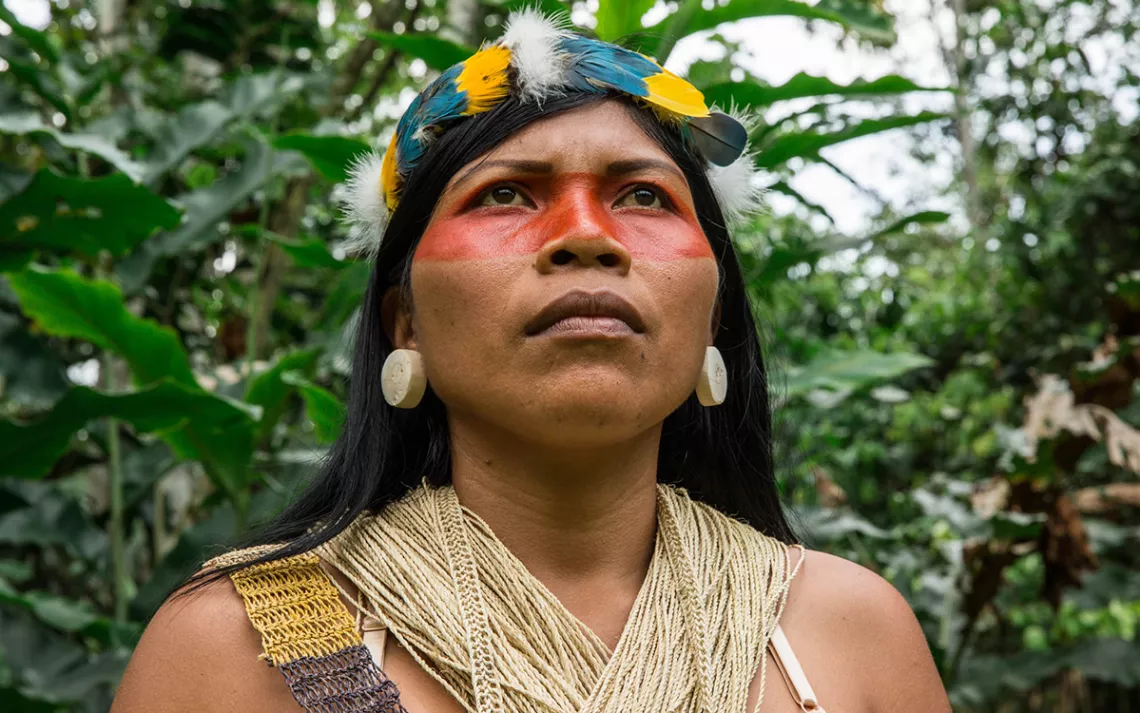
Nemonte Nenquimo, Waorani leader and president of CONCONAWEP (Coordinating Council of the Waorani Nationality of Ecuador-Pastaza) and one of the founding members of the Ceibo Alliance. | Photo Jerónimo Zuñiga/Amazon Frontlines
In the middle of the northern Ecuadorean rainforest sprawls the oil town of Lago Agrio. From Quito, it’s a day’s drive east through the Andean foothills, one spectacular vista after another until the landscape flattens out and the city announces itself with the sights and smells of the industry that built it, atop Kofan Indian hunting grounds, in the 1960s.
Buffered by petrochemical plants and flares, Lago Agrio has been described as a 20th century El Dorado. No legendary city of gold was ever discovered in the Amazon, but it was here that the vastness of the region’s oil deposits was first comprehended and exploited. Half a century later, Lago Agrio is hub to a thickening network of roads and pipelines that stretch ever deeper into the country’s rainforests, some of the most biologically and culturally rich of the upper Amazon. While great expanses of this primeval forest remain pristine, much is degraded or under threat; an area the size of Rhode Island is so steeped in poison it’s known as the Amazon Chernobyl.
In the 1960s, the US oil corporation Texaco arrived and named its new headquarters Lago Agrio, or Sour Lake, after its corporate hometown in Texas. The local Indigenous people, the Kofan, were disregarded as nuisances. Texaco razed Kofan hunting grounds, built hundreds of wells, and paved the first roads in what has become a bustling city. The riverbank where the Kofan’s prized bamboo grew tallest was turned into a toxic waste dump.
More than 50 years later, the Kofan, in partnership with other Ecuadorean Indigenous groups, are engaged in new and sometimes surprising forms of resistance against the oil drillers—a unique sort of traditional-meets-modern style of activism that they hope can ultimately stop the oil and gas extraction in their traditional lands.
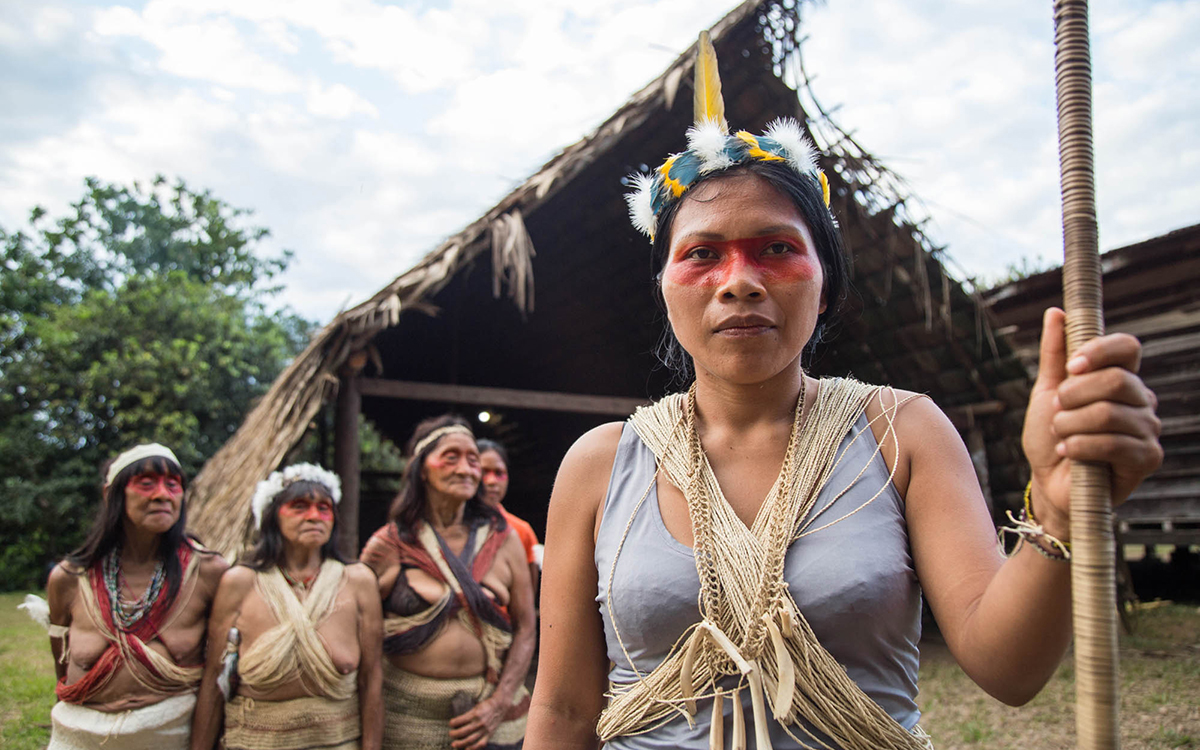
Nemonte Nenquimo, Waorani leader and president of CONCONAWEP (Coordinating Council of the Waorani Nationality of Ecuador-Pastaza), and one of the founding members of the Ceibo Alliance. | Photo Jerónimo Zuñiga/Amazon Frontlines
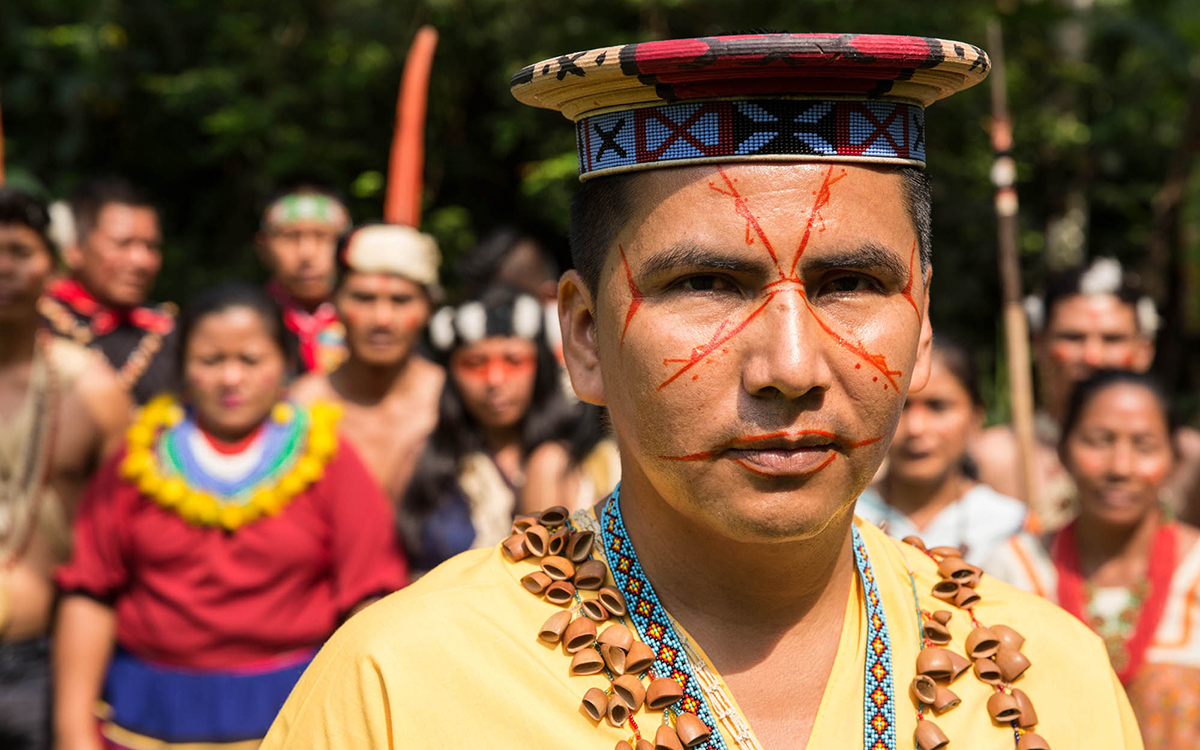
Hernán Payaguaje, Secoya leader and executive director of the Ceibo Alliance. | Photo Jerónimo Zuñiga Amazon Frontlines
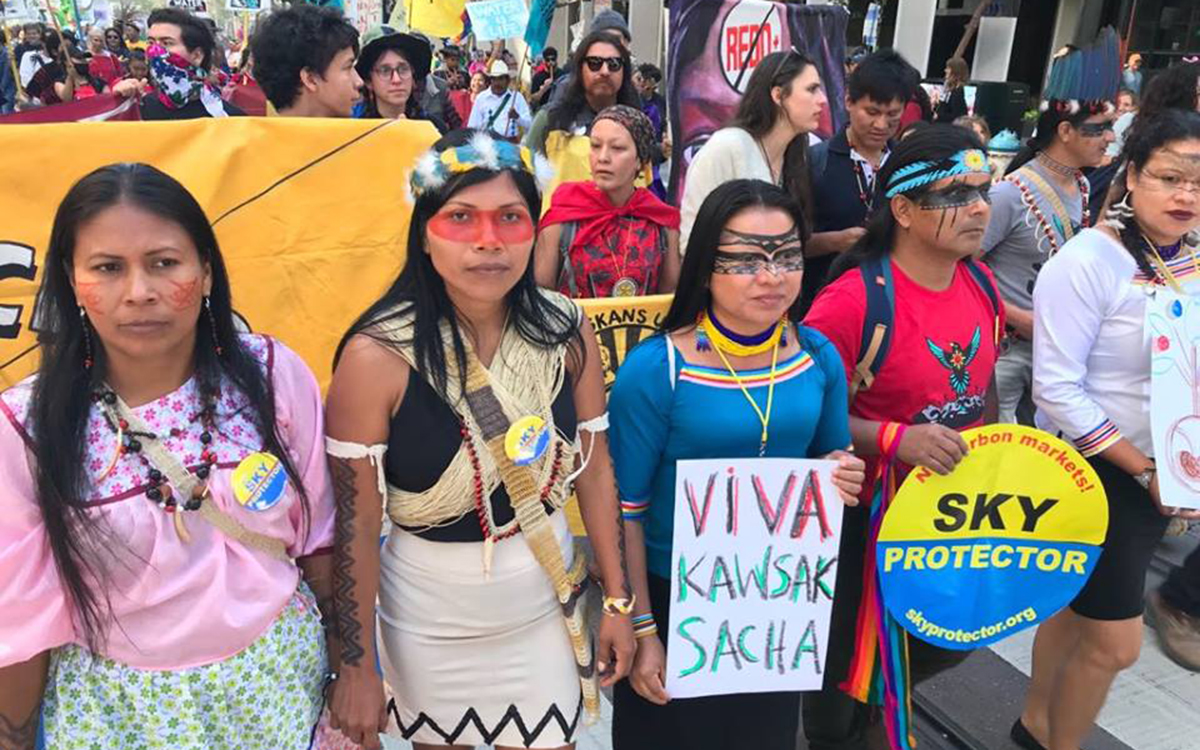
Indigenous women leaders from the Ceibo Alliance, Nemonte Nenquimo and Flor Tangoy, from the Waorani and Siona nations, participate in San Francisco's Rise for Climate march. | Photo Amazon Frontlines
On Lago Agrio’s northern edge, off the paved road to nearby Colombia, is a gravel road, easy to miss. It leads uphill to a dirt clearing used by local kids as a soccer field. At its center is a rusted-out Texaco oil well. Behind the long-abandoned pumping station is an unmarked gate, beyond which another gravel path descends into a bright-green world—broadleaf forest full of tropical birdsong and red-bellied titi monkeys. Beneath this canopy is a jungle campus. Walkways shaded by fruit trees connect a dozen bungalows, office cabins, open-air meeting spaces, and a communal kitchen lined with hammocks. The lush oasis, built on a once-contaminated slope next to an oil well, is evidence of the forest’s resilience—and a testament to the resilience of the local forest peoples.
The oasis is called Amisacho, the old Kofan Indian name for the region, taken from the local bamboo used to cut the umbilical cords of newborns. The jungle settlement is home to a rotating cast of Indigenous community leaders from the Ecuadorean Amazon, accompanied by biologists, lawyers, engineers, and activists from around the Americas and Europe. To those who live or work there, the forest compound of Amisacho is a kind of antibody to the social and spiritual sickness of industrial society—a place for building Indigenous power to confront the legacy of the past and new threats from industrial projects.
“We all share a vision and we’re creating a path for the protection of our forests,” says Alex Lucitante, a Kofan leader from one of the organizations based at Amisacho, called the Ceibo Alliance. “When extractive activities enter our ancestral territory, people start to depend upon the goods and services that the Western world offers. They begin to care less for their lands and lose elements from their culture. Where culture has been weakened or lost, leaders become inclined to allow oil and mining companies to enter the territory, creating a lot of division in the communities.”
This vicious circle has been occurring for half a century. Texaco (now Chevron) dumped waste and committed spills with abandon for decades before pulling stakes in the late 1990s. Since then, the Ecuadorean government’s state-controlled energy firm, Petroecuador, has expanded oil production deeper into the forest, apace with the rise of extractive industry throughout the neighboring rainforest nations of Peru, Colombia, and Brazil. Almost 70 percent of the Ecuadorean Amazon is now divided among oil blocks—some active and others slated for exploration or development. In the last decade, nearly 1,000 spills have released an average of 4,000 gallons of petroleum per day, much of it into the watersheds of Indigenous communities along several important Amazon tributaries.
It was against this state of emergency that the region’s four main ethnic groups—the Siona, Waorani, Kofan, and Secoya—gathered at Amisachoin 2017 to found the Ceibo Alliance. Working together with a westerner-led organization, Amazon Frontlines, the Indigenous groups are coordinating a multilayered strategy of defense and offense that includes territorial mapping and monitoring programs; law and journalism workshops; micro-solar projects; cultural revival; and precedent-setting legal work to strengthen Indigenous communities’ internationally recognized right to free, prior, and informed consent before any development occurs in their territories.
Empowering a new generation of forest guardians, say the Indigenous activists, will require giving them a stake in the future of their ancestral lands.
“The defense of our territories and the recovery of ancestral practices help us to really understand who we are as Indigenous peoples,” Lucitante says. “It enables us to strengthen our identity and reflect upon the past. Our ancestors lived for thousands of years without needing to sell their territories. It’s important for the youth to understand this. Once they understand the importance and meaning of our land, they are empowered to fight for it.”
It is not overly dramatic to say that, for the Kofan and their allies, Amisacho is a last stand.
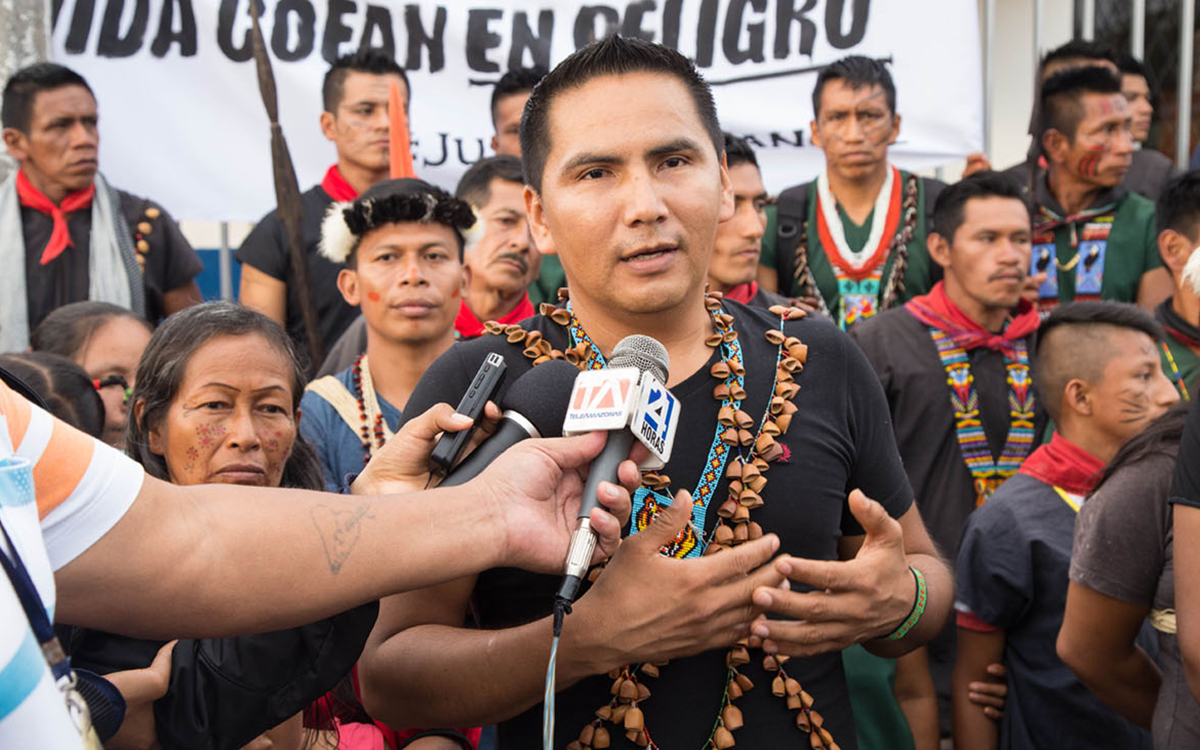
Hernán Payaguaje, Secoya leader and executive director of the Ceibo Alliance. | Photo Jerónimo Zuñiga/Amazon Frontlines
II.
I first visited Amisacho several years ago while reporting a story about Chevron’s legacy in the region. Back then, it was a sleepier place. It was mostly used by a California native named Mitch Anderson, who in 2013 quit his job in San Francisco running campaigns for Amazon Watch and decamped to Lago Agrio to work directly with Indigenous communities affected by oil development. For five years, he directed a program that brought more than 1,000 rainwater filtration systems to dozens of roadless villages across more than 5 million acres of forest. That project laid the foundation for the organization he founded in 2017, Amazon Frontlines, as well as an unprecedented political union of Ecuador’s native peoples, the Ceibo Alliance. Five years ago, Anderson mostly Amisacho as a base to recharge between extended stays in the deep forest, where he and his Indigenous partners wrestled with the Herculean logistical challenges of transporting unassembled water systems—sheets of galvanized metal, thousand-liter catchment tanks, zinc roofs, heavy bags of concrete, sand, and quartz—using skinny and often unstable canoes.
When I visited Amisacho again last spring, it was a place transformed. All of the bungalows had been converted to dorms. Groups of Indigenous youths on laptops held court in the meeting spaces. Gringos from Amazon Frontlines’ multinational support team conducted Powerpoints and Skyped with foreign capitals.
Much of the work was focused on a Waorani “counter-mapping” project that is intended to show the Ecuadorean government and global civil society that the Waorani’s ancestral forest—a mountainous area the size of Yellowstone National Park at the headwaters of the Amazon—is more than a collection of resources. Since the era of the Inca, the Waorani have been known as fierce defenders of their land. When Christian missionaries made first contact with the Waorani in the 1950s, not all of them lived to tell the tale. Today, the Waorani face grave and immediate threats to their more than 1 million titled hectares, and they are still resisting—though they have traded their chonta spears for a new kind of resistance.
The mapping project is microcosm of the strategy being honed by Amazon Frontlines and the Ceibo Alliance. It’s led by a young Waorani leader named Opi Nenquimo, with technical support from an Oakland-based group Digital Democracy. The project’s immediate goal is to present a symbolic alternative to political and industrial maps depicting Waorani territory (and Indigenous lands generally) as an uninhabited resource zone to be exploited. Where most base-layer maps produced by the government show undifferentiated nature and petroleum deposits, the interactive Waorani map depicts historic ceremonial and battle sites, ancient cave-carvings, jaguar trails, medicinal plants, animal breeding grounds, important fishing holes, creek-crossings, and sacred waterfalls.
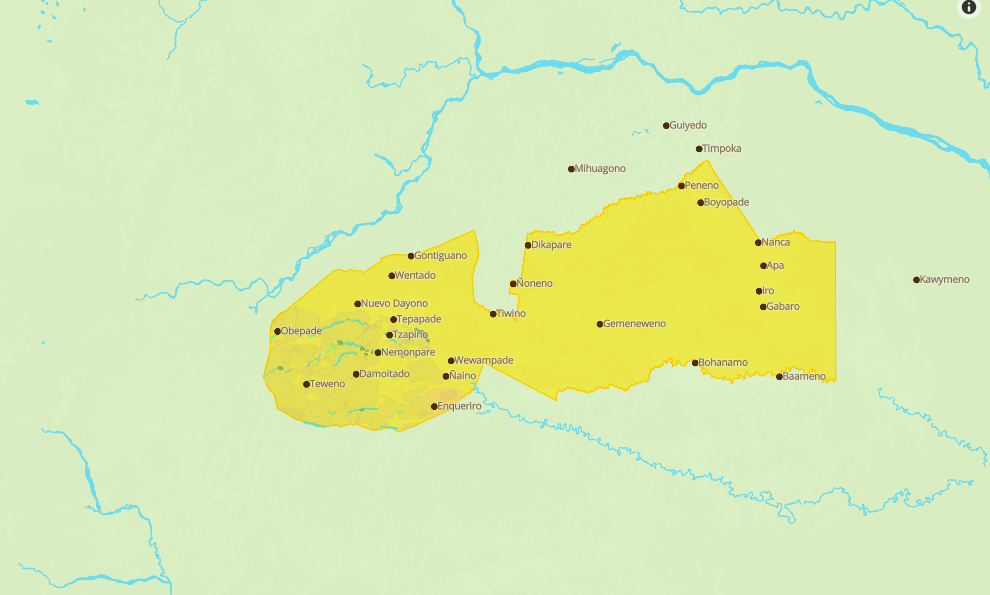
Click here for an interactive version of this map.
“Our map shows all of the things that don’t have a price,” Nenquimo says. “Building it, we also build our communities. The surveying and monitoring bring the youth and elders together. We reflect on the meaning of our territory. We think strategically about our long-term survival.”
The mapping project is part of a wider strategy to build up Waorani capacity for the struggles ahead. It follows years of inter-ethnic and inter-generational organizing meetings at Amisacho that brought together isolated Waorani villagers and Siona, Secoya, and Kofan activists with long experience living inside oil zones.Through these meetings, the Waorani learned that the proposed blocks were just the beginning. They would involve cutting new roads deep into Waorani land, opening the way for first a trickle, and then a flood, of illegal miners and loggers.
“The experiences of the Kofan and Secoya was seared into them,” Mitch Anderson says of the meetings. “Not only the details of contaminated water and poisoned fish but about how oil strips communities of their ability to survive in the forest, creating pressures on the youth to work for the companies and loggers to survive in the money economy.”
The map will feature in a lawsuit the Waorani plan to file against the Ecuadorean government in February to block a planned oil auction. The idea is for the Waorani map to serve as a portal through which the world can see exactly what is being threatened by the arrival of industry and roads. If the development proceeds, the map will help communities monitor and document the impacts, including the kind of ground-level degradation often missed by satellite monitoring. (In October, Amazon Frontlines won a legal victory protecting the forests around Sinangoe from a proposed mining concession.)
While technologists are a regular presence at Amisacho, nobody there has any illusions about the power of apps alone. “Technologies can help us to detect invasions in our territory, but without our own Indigenous land patrol, without our connection to our territory and our ancestral knowledge, technology is of no use,” says Alexandra Narvaez, a leader from the Kofan village of Sinangoe.
It wasn’t so long ago that Indigenous power and practices, based on ancestral knowledge, was dismissed in the West. The cultures and struggles of riverine hamlets in the Amazon were seen as the narrow concern of anthropologists and ethnobotanists; groups like the Waorani existed “outside of history.” No more. Around the world, Indigenous peoples manage rainforests equal to an area 10 times the size of California. These lands contain an estimated 300,000 million metric tons of stored carbon, or more than three decades of annual global energy emissions.The forest peoples of Africa, Asia, and Latin America are now accepted as central players in the race to protect the “lungs of the earth” before they are degraded beyond the point of return and become “tailpipes of the earth” as they turn into net CO2 sources. A growing body of research supports Indigenous claims that they are the natural stewards of this carbon; any serious climate mitigation strategy must include expanding Indigenous peoples’ control over their lands.
“Indigenous people have a reverence for the lessons and generosity of the rainforest, because for them it is their pharmacy, market, and temple,” Anderson says. “We urgently need a model for putting western resources at the service of Indigenous values and frontline experience.”
Last September, Anderson and four members of the Ceibo Alliance brought this message to San Francisco at the invitation of then-governor Jerry Brown of California.
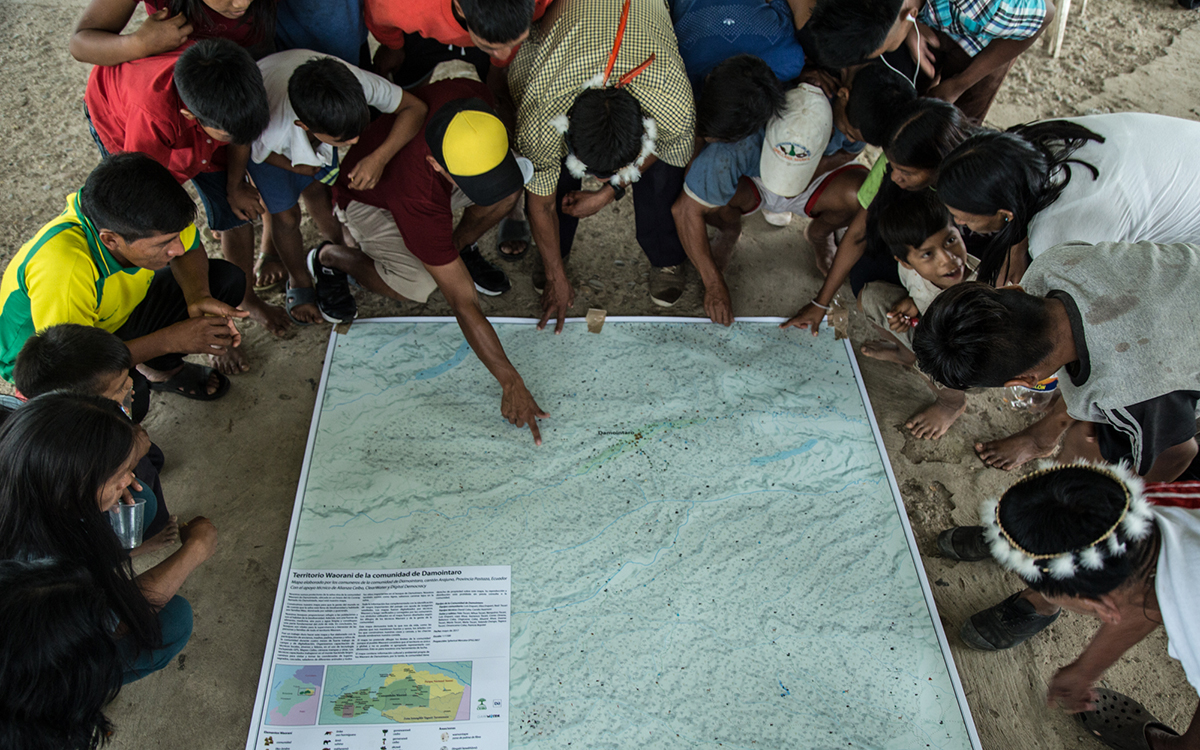
Indigenous Waorani community members review the map of their ancestral territory, Pastaza region, Ecuadorian Amazon. | Photo Mitch Anderson/Amazon Frontlines
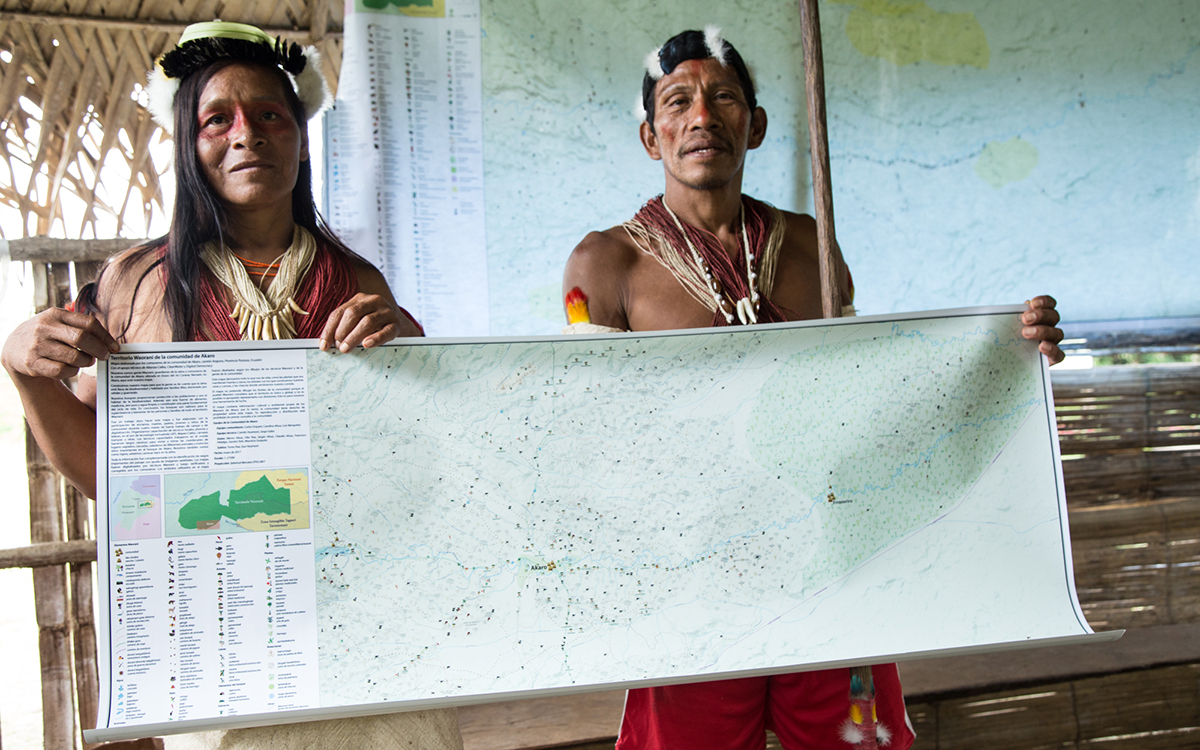
Indigenous members of a Waorani community in the Pastaza region display the map of their ancestral territory, Ecuadorian Amazon. | Photo Mitch Anderson/Amazon Frontlines
III.
It was easy to spot the Ceibo delegation at the Global Climate Action Summit. Most of the delegates wore standard business attire, the West’s uniform for talking about serious things. The villagers from the upper Amazon—two Siona and two Waorani—came in their traditional tunics, feathered crowns, and red face paint made from the achiote seeds. The clothes were an expression of their cultures, as well as a sharp dissent from the West’s materialist understanding of power and seriousness.
The summit delegates had come to San Francisco to craft decarbonization strategies that bypass Washington, D.C., and shore up the Paris Agreement. Mayors and governors brought their control over local grids and emissions rules. Walmart, Unilever, and McDonald’s came with the economy-warping capacities of their supply chains and market shares. The philanthropic foundations paraded the combined largesse of generations of capitalist fortunes. Bay Area tech companies brought blueprints for their latest world saving gadgets. Environmental and social justice activists supplied chants and protest signs—not a few challenging the summit’s faith that a system based on consumption and growth can ever be decarbonized.
The Ceibo delegation, meanwhile, brought a hard-earned perspective on fossil fuels and climate politics shaped not by hopes of new markets and abstract emissions targets, but forged in the brutal realities of poisoned water, chronic illness, and shrinking hunting and fishing grounds.
One of the Ceibo four was Nemonte Nenquimo, a young Waorani woman who grew up in a roadless forest now being crowded by oil companies. “When I think of technology, my first thoughts are of the chainsaw, the bulldozer, the pipeline, and the oil well,” Nemonte said during one summit gathering. She told a room full of technologists and NGOs that social media, drones, camera traps, and GPS can be used to empower her generation of Indigenous leaders—in her activism she uses them all—but unless the values of her elders are preserved in the forest, and spread to the west, they will fail. “Our culture is the real source of our power,” she said. “Without it, we cannot protect the forest. And without the forest, we cannot protect our culture.”
In San Francisco, the Ceibo group was welcomed with pledges of solidarity and support. And the big talk was often backed up by resources: One announcement at the conference involved a $500 million initiative to support frontline forest communities.
During the last decade, the world of rainforest advocacy and philanthropy has, in many ways, changed for the better. But look closely at the commitments made at the Global Climate Action Summit and it’s clear these pledges often reveal something of the old paternalism; there are few promises of Indigenous control or leadership.
“I fear there’s still a lack of self-reflection and appreciation for the immediacy of the struggles happening right now on the ground,” Anderson told me by phone from San Francisco, a day after accepting an activist award from the Leonardo DiCaprio Foundation. “People [at the summit] are presumably talking about the same forests we’re living in and watching be assaulted, but there is a disconnect. Missing is an understanding of the strength and determination of people protecting their homes day in and day out against a bewildering array of threats. Support needs to go to the proposals and ideas of the people who are not only protecting the forests as carbon sinks but as their homes.”
The Ceibio delegation left San Francisco both hopeful and wary: hopeful that the growing debate over the future of the rainforests includes Indigenous seats at the table but wary of grand proposals to support Indigenous stewardship that are low on details about local input.
Hernán Payaguaje, a Secoya leader and Ceibo’s executive director, wonders what took the rest of the world so long to catch up to their long-running resistance. “We’re glad people are talking more and more about the important role of Indigenous peoples in protecting forests,” he says. “But it’s surprising to us that this is happening only now. Our ancestors have been caring for and defending these forests for thousands of years.”
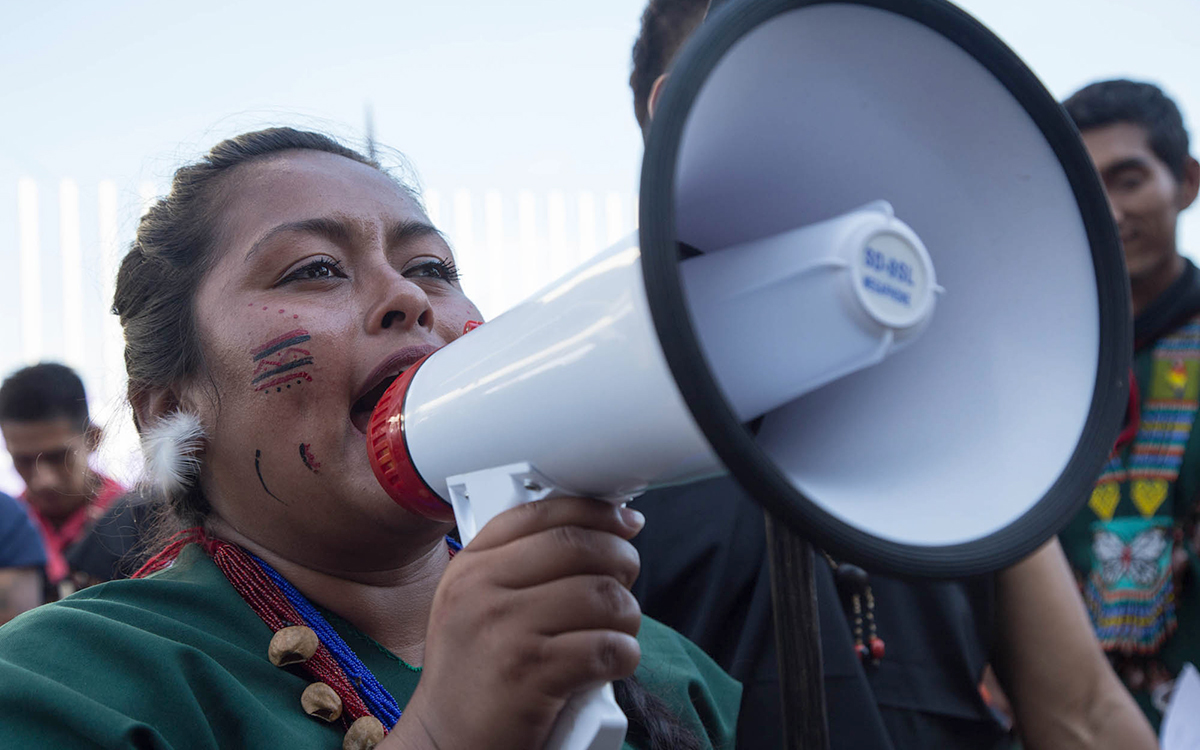
Alexandra Narvaez, youth leader from the Kofan community of Sinangoe and member of the community guardia (land patrol). | Photo Jerónimo Zuñiga/Amazon Frontlines
 The Magazine of The Sierra Club
The Magazine of The Sierra Club



